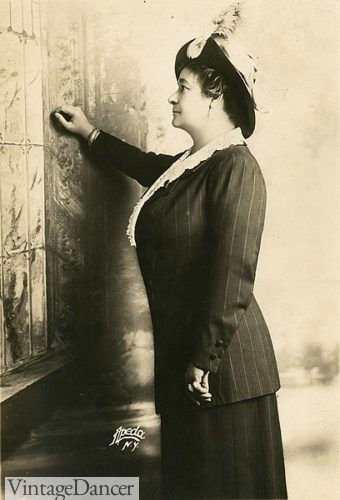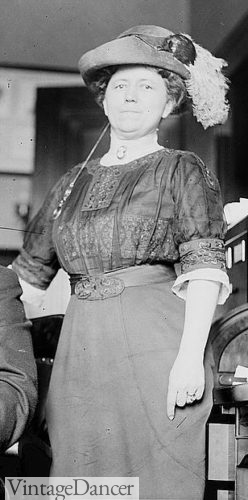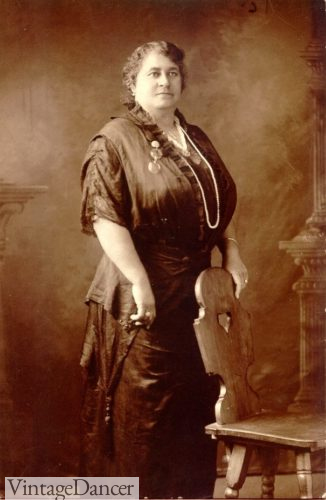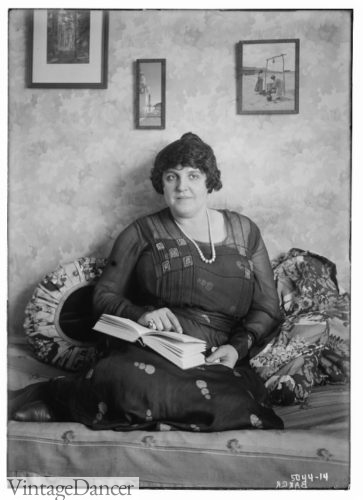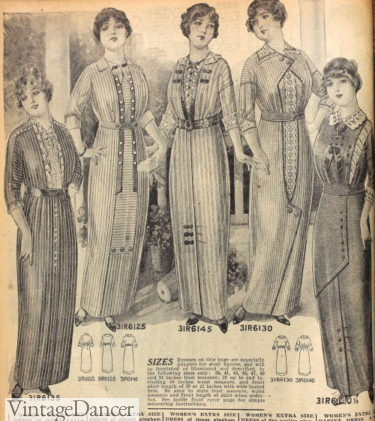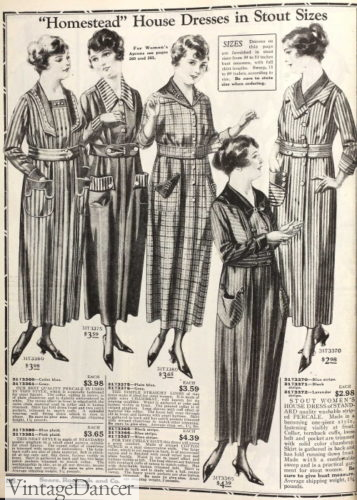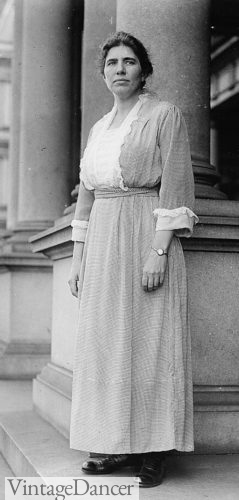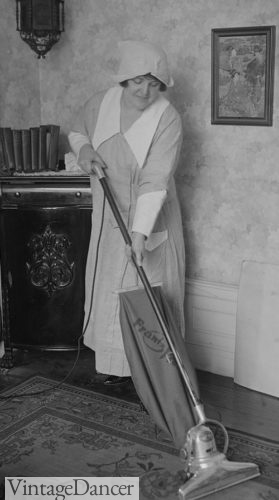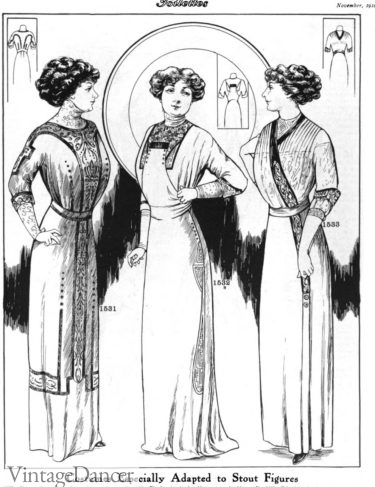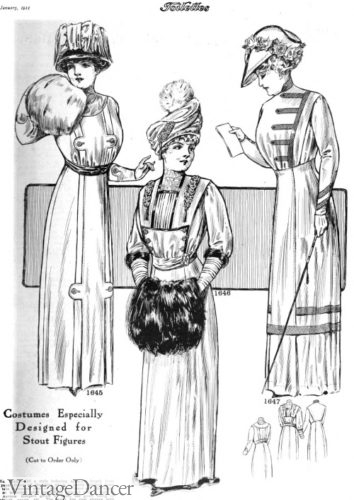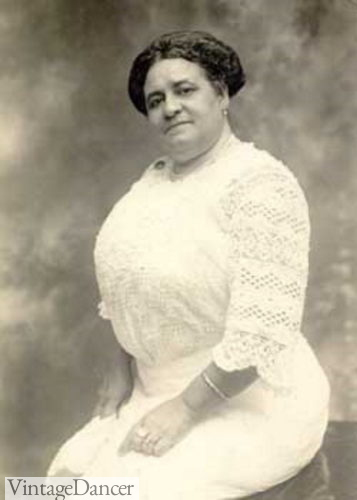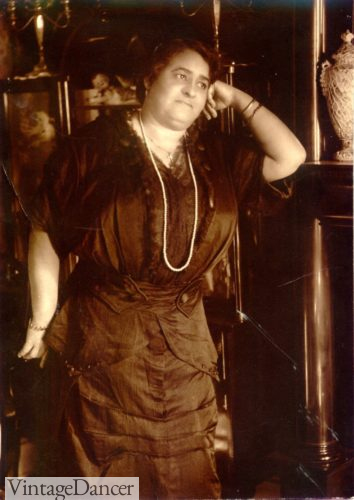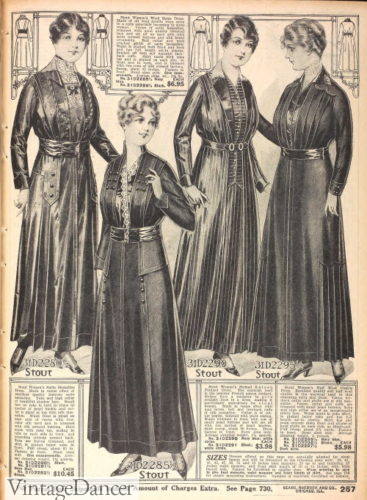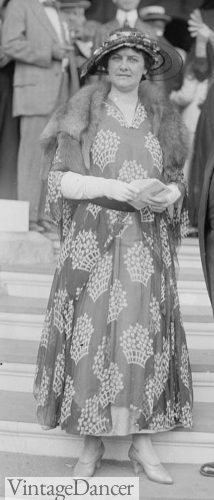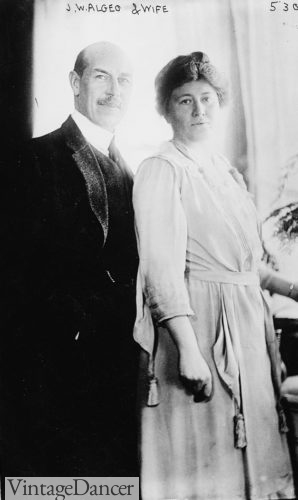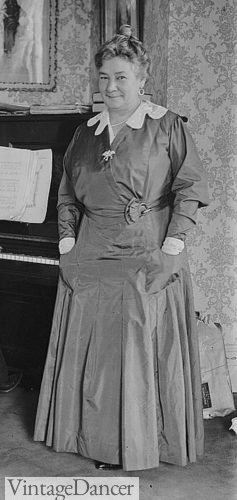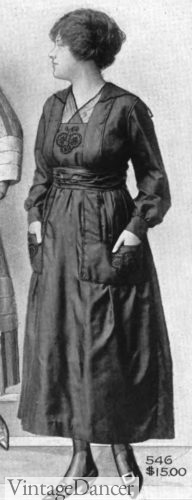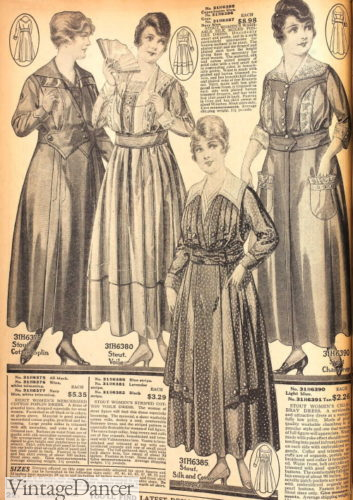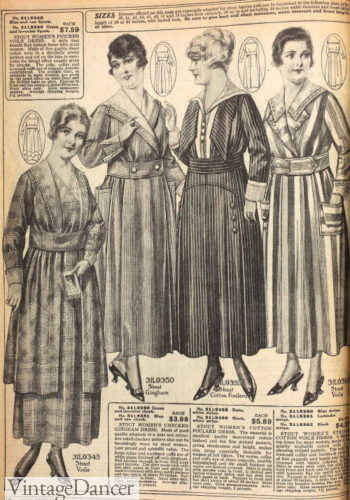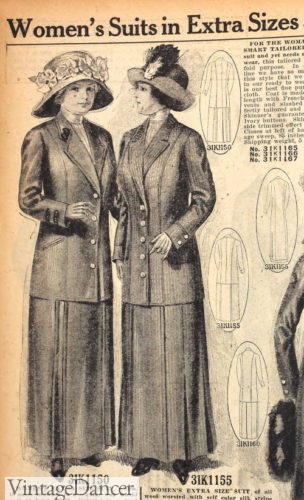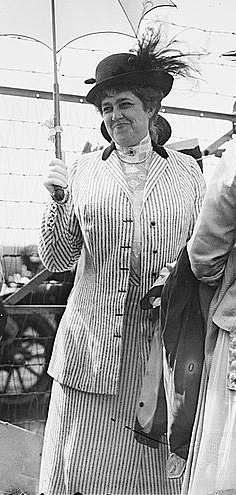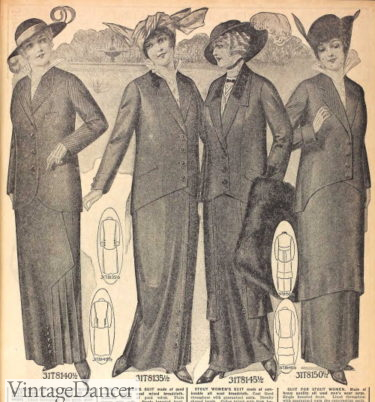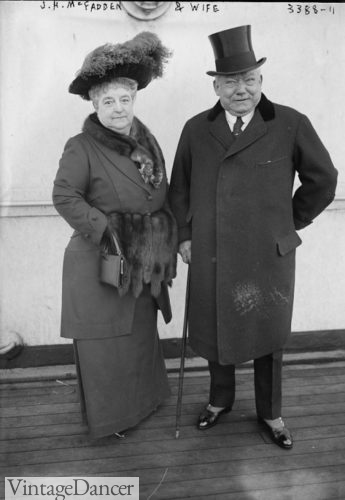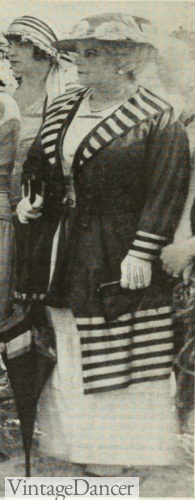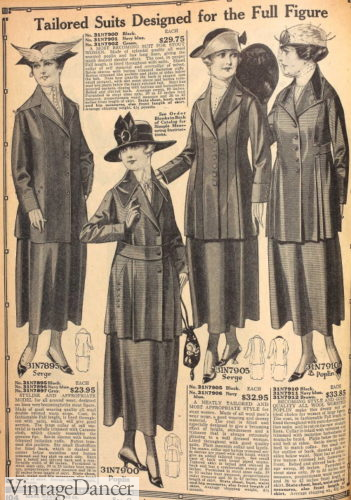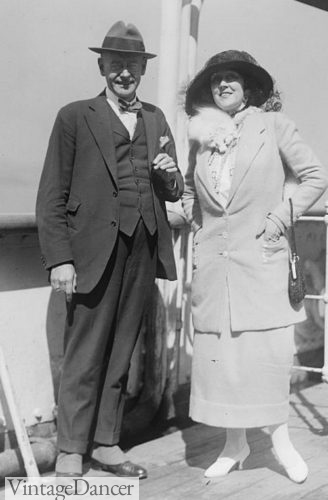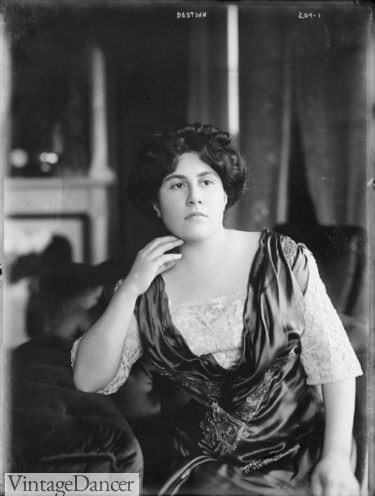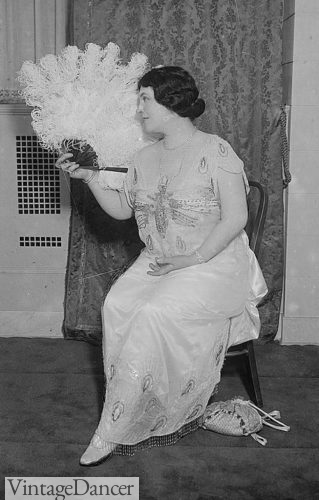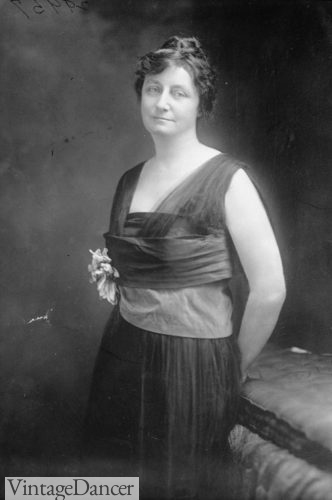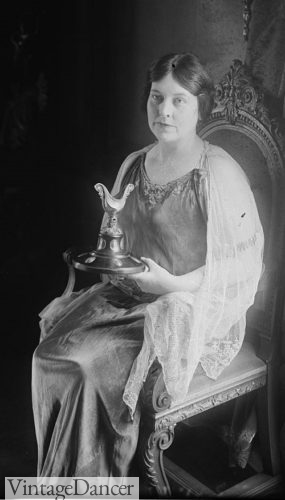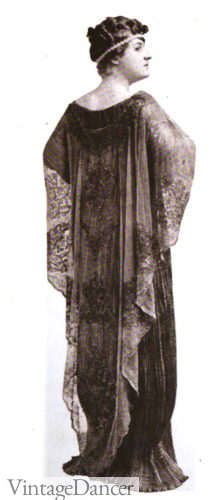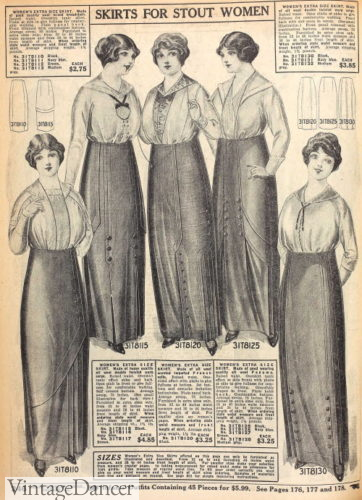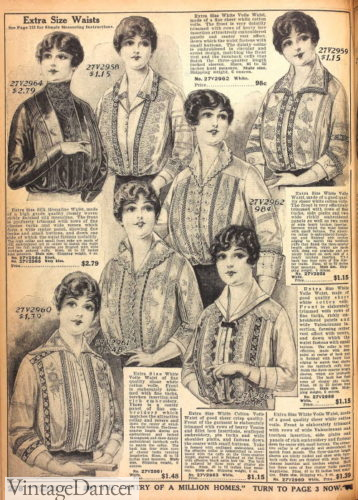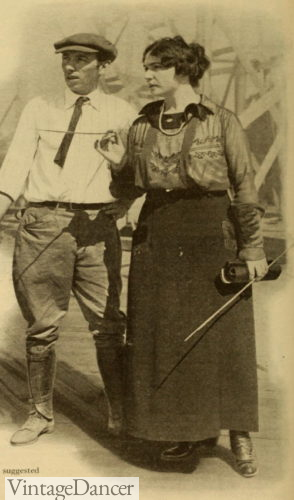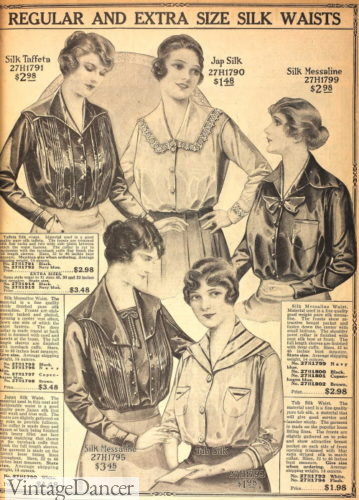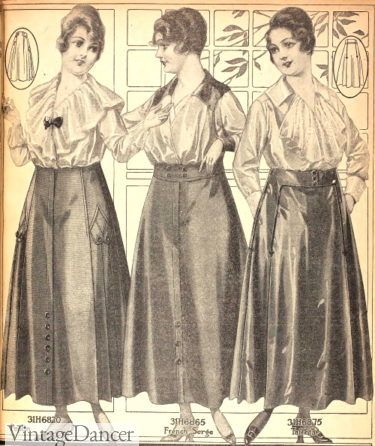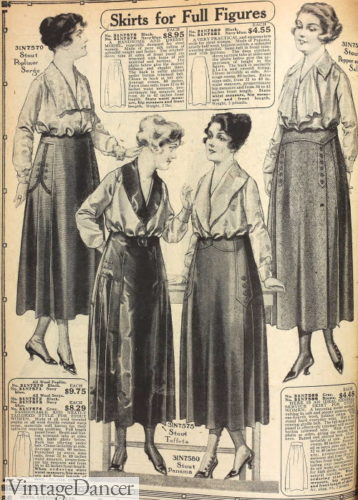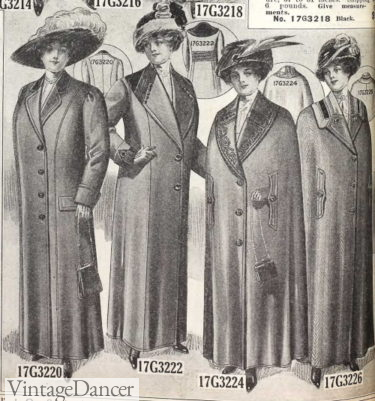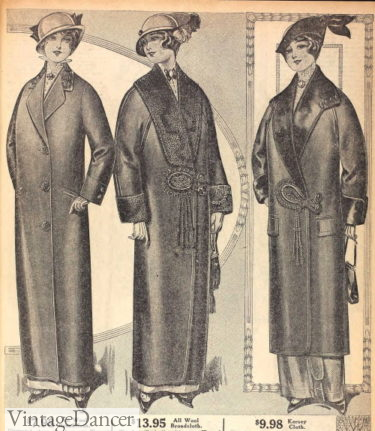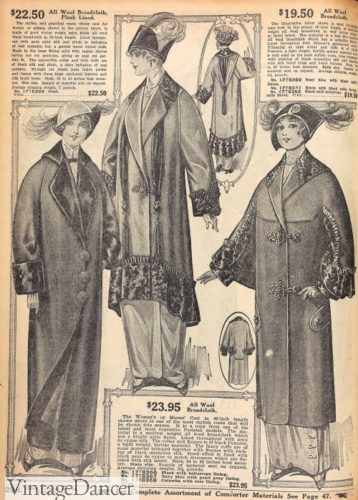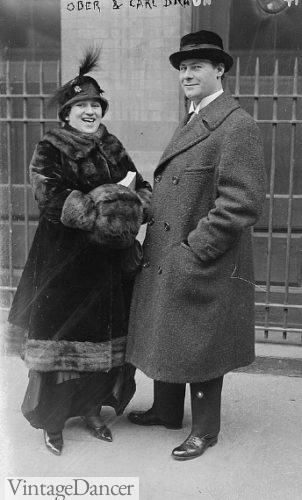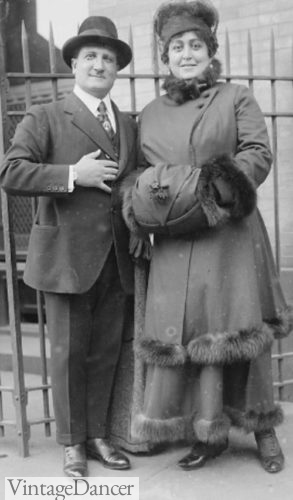Unlike the 1900s, where ready-made plus size clothing was almost non-existent, the 1910s began to take the full figured woman seriously. With 12 % of the population considered Stout (meaning strong), clothing shops and mail order catalogs saw a need to not only offer women clothing in extra sizes, but also created designs specifically for the curvy figure. They also began to create a separate department area for women to shop in, and illustrated fashions on plus size bodies.
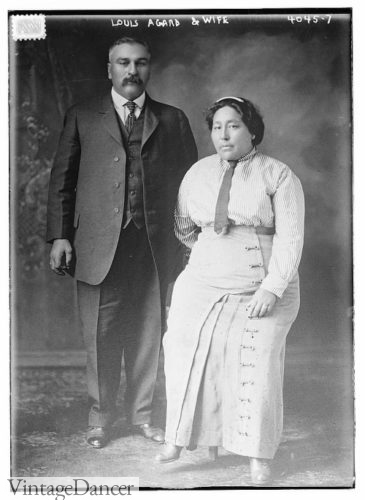
Louis Agard and his Wife
Lane Bryant was one of the first to open a dedicated stout size and maternity clothing shop and mail order line in 1900. The advertisement below says they make up to 56 inch busts and carry them in stock!
There was also Leonard’s, F.F. Models, Graceline Stout-Style, R and Z Stout by Rueben and Zuckerman, The Rosenbaum, Super Customade, and Le Mere Frocks, who created their own patterns and designs.
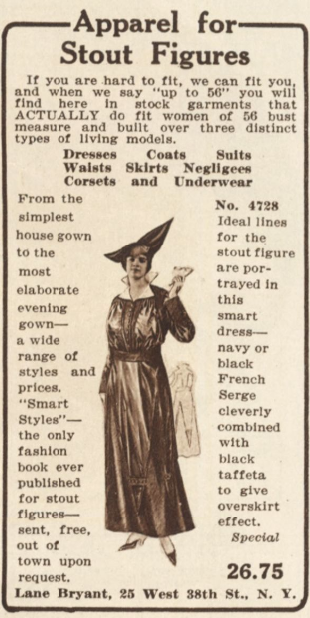
1915 Ad for Lane Bryant New York Shop
The terms plus size, extended size, and curvy are modern ones. “Extra Sizes” was used in the 1900s, while “Stout Women” sizes was the norm from the 1910s onward.
In the 1910s, ready-to wear clothing was based on bust and waist measurements. Average sized clothes were for bust sizes 22 to 40. Stout sizes were offered for busts 39-52 inches and waist sizes up to 40 inches.
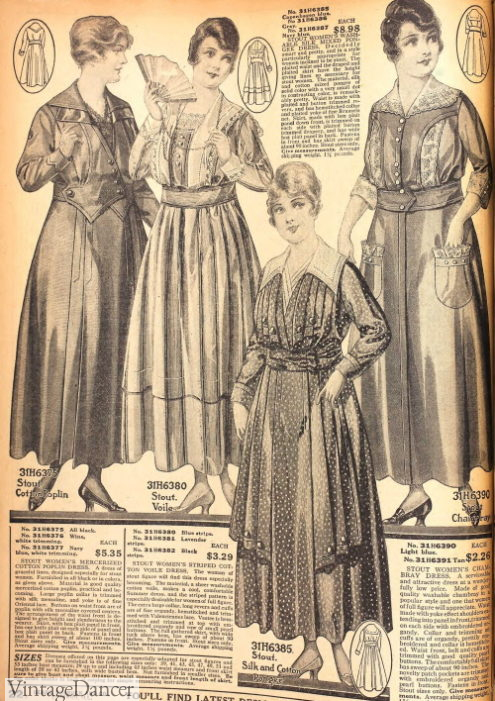
1917 Stout Women’s Dresses
Changing Fashions
Whereas the Edwardian era, 1890 to 1910, embraced the voluptuously curvy women, the 1910s shifted into a new silhouette devoid of curves. The tubular or column shape required corsets to be redesigned with a long flat front, and forced fabric to be draped in long panels.
- 1913 Ernestine Schumann-Heink
- 1913 Ella Hunter Perky
For the stout woman, the Empire-waistline of the early 1910s was equally flattering as the curvy Edwardian’s. From underbust to thigh, the line was smooth and straight. The typical dress featured long full sleeves, a high neckline, loose bodice, and a slender skirt with matching thin belt. Additional draping, sashes, and extra panels added vertical interest.
- 1910 Maggie Lena Walker
- Elsie Baker
From the start of WWI in 1914, women’s fashion changed again. The corset remained flat, but now clothes were loose and comfortable. Wide A-line skirts with sash waistbands and roomy blouses with open necklines were a welcome relief from the 1910s tubes.
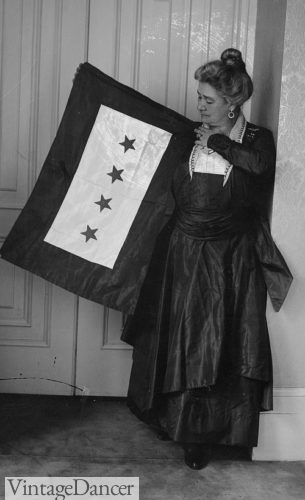
1915 Ernestine Schumann-Heink
Special attention was given to the color palette of Stout women’s clothing. Most shops and catalogs played it safe by only offering dark muted colors thought to minimize any unwanted curves: black, navy blue, plum, brown, medium grey, burgundy, or dark green. House dresses and daywear were light blues, lavender, tan, and grey. White blouses and skirts were offered in the summer.
“White is only unbecoming to stout women when it is cut up by contrasting trimmings or accessories. For instance, a colored belt should not be worn, or even a neck ribbon of color, — no matter how dainty.” – Talks on successful gowning, by Elizabeth Lee, 1910
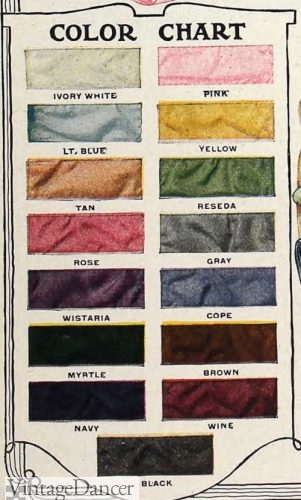
1918 Silk Colors (Avoid Pink, Rose, and Yellow – All Others are OK)
Colors to avoid were pastels – pale pink, pale green, mauve, yellow, or baby blue. Deep off-whites such as champagne or fawn were also not good choices. Of course, many women ignored these rules, choosing whatever color delighted them.
Handmade clothing designers worked with women to find appropriate colors that best matched her completion and hair color, choosing from a variety of trending colors.
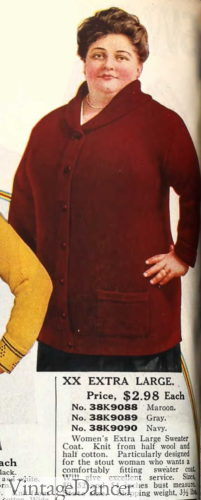
1917 Cardigan Sweater in Maroon
Large prints were less common in stout sizes. The one exception was vertical wide stripes, popular during WWII. Small checks, stripes, plaid, flowers, and polka dots were seen on house dresses and occasionally suits. Patterns were always vertically orientated to lengthen the silhouette.
Most streetwear and evening clothes were a solid color with matching belts, collars, pockets, trim, and buttons. White collars were the one exception to the matching color rule. Black trim was also acceptable on any dark shade.
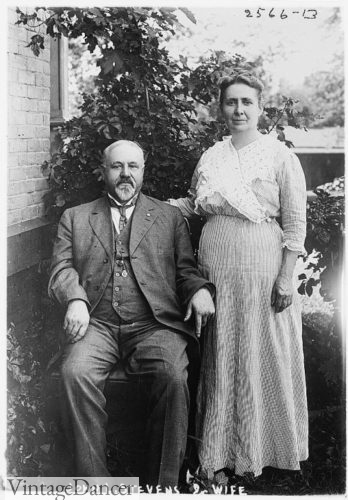
1912 Rowena Edson Stevens, Suffragette
Fabric selection was also very important to the 1910s plus size woman. Gabardine, georgette, broadcloth, chiffon, velvet, taffeta, charmeuse, silk jersey, and crêpe de Chine fabrics that had minimal shine and made the least amount of “noise” were thought to be the most becoming. Natural fabrics such as cotton, linen, and wool were always good choices.
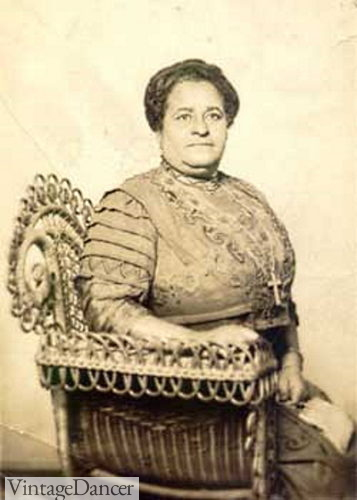
1910s Maggie Lena Walker
The following are photographs and catalog illustrations from 1910 to 1919. Most are not illustrated on plus size models, and those that do hardly seem “plus.” Considering the start of the stout size range begins at a modern size XL, this is not surprising.
Plus Size House Dresses
Narrow vertical stripes in grey, black, lavender, or pale blue were a favorite pattern. Checks and plaids gradually grew bigger and bolder heading into the 1920s. More about Edwardian house dress history.
- 1914 House and Day Dresses
- 1919 House and Day Dresses
- 1919 Hannah Jane Patterson
- Elsie Baker (1919-1920?)
Plus Size Afternoon Dresses
From spending time a home to shopping, these all-day dresses ranged from simple to elegant. Earlier dresses featured a high round neckline with embroidery. Then came dresses with lower V necklines and wide collars that suited women well. The long lapels helped lengthen the body, while the sash belt defined the waist. Read more about 1910s dress history here.
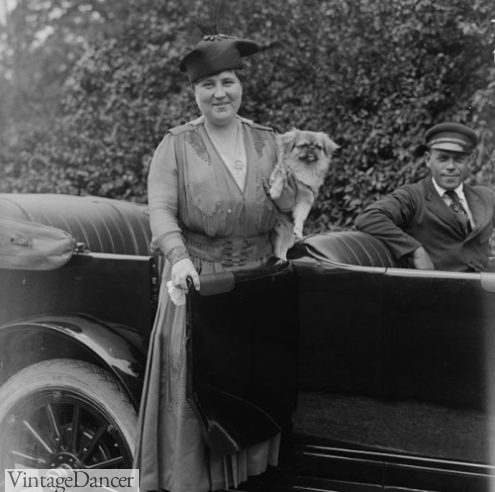
1915 -1920 Opera Singer Florence Hinkle
“The large woman’s bodice in front should be loosely draped between the bust and abdomen, the fullness serving to hide the hollow at the waist line that suggests a valley between two mountains. The fulness may be becomingly drawn in plaits—not too tightly—to a point, and seemingly held there by a girdle that comes only from the under-arm forms.” – What to Wear; A Book for Women by Belle Armstrong Whitney, 1916
- 1910 Dress Patterns for Stout Women
- 1911 Dress Patterns for Stout Women
- 1910s Maggie Lena Walker
- 1910s Maggie Lena Walker
- 1915 Daywear Dresses
- 1916 Wife of Martin H. Glynn
- Mrs. James Algeo Was a Suffragette
- 1917 Schumann-Heink
- 1917 Black or White Dress
- 1917 Stout Women’s Dresses
- 1918 House and Day Dresses
Plus Size Women’s Suits
A good suit (skirt and jacket) with a white blouse was a standard outfit for daywear – especially to travel in, while attending business, and when helping with social causes (like suffragette marches). Made of sturdy wool in winter or light linen in summer, they were usually dark solid colors, but black and white vertical stripes were very trendy too.
- 1912 wool suits
- Singer Agnes Huntington
- 1914 Walking Suits
- 1915 Wife of J.H. McFadden
- 1917 Dress with Jacket
- 1918 Daywear Suits
- J.A. Hammerton & Petrova (Prior to 1920)
Plus Size Evening Dresses
Fancy afternoon and evening dresses were ideal for dinner parties, balls, galas, and the theater. Column shapes and slip dresses seemed to be the preferred styles for evenings. More about evening gowns here.
“…if her shoulders are narrow and her bust large, the way her waist is trimmed is of vital importance. If braid, an embroidered band or lace insertion is used, it should run from the middle of the shoulder seam straight down to the waist line. There should be no cut-off effect; but the longest line possible should be secured.” – The Magic of Dress by Grace Margaret Gould, 1911
- 1900 Emmy Destinn
- Mrs. J.S. Blackton
- 1918 Suffragette
- Mrs. J.S. Blackton
- The Cape Back Slip Gown was Very Popular
Plus Size Skirts and Blouses
The dark skirt with white blouse was a classic pairing for all women during the decade.
“The stout woman should never have her waist cut round at the neck. The square neck or the V shaped neck will prove much more becoming. And here is a little suggestion worth remembering. In cutting the waist out either square or in a V have the opening come as close to the collar line at the shoulder as possible.” – The Magic of Dress by Grace Margaret Gould, 1911
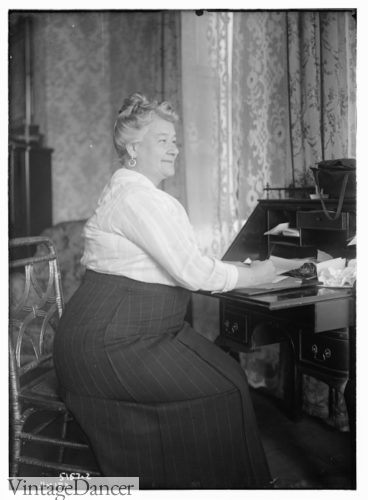
Ernestine Schumann-Heink 1910s
“The average stout figure will find the many gored skirt fitting the hips smoothly and flaring about the feet an excellent model. Lengthwise tucks may be indulged in when they are in fashion, or a little fold about the feet is admissible. Another skirt trimming that is often found becoming is a little foot frill made quite full. This appears to increase the circumference at the bottom — thus diminishing the size at the hips — without detracting the least bit from the length of the skirt, and these are the effects that the stout woman should seek.” – Talks on Successful Gowning, by Elizabeth Lee, 1910
- 1914 Skirts and Blouses
- 1915 Blouses
- 1917 Ms. Weber
- 1917 Blouses
- 1917 Blouses and Skirts
- 1918 Skirts and Blouses
Plus Size Coats
“A semi-fitting coat just defining the figure is far and away the best choice. She must, however, use discretion in choosing the length. The short, stout figure may wear an Eton coat, one ending at half length and a full length wrap. Many stout women prefer the length ending just at the line of the hips. But this is a mistake.” – Talks on Successful Gowning, by Elizabeth Lee, 1910
- 1911 Plus Size Coats
- 1914 Plus Size Coats
- 1914 Fancy Plus Size Coats
- Opera Singer Margarethe Arndt-Ober
- 1915 Opera singer Margaret Matzenauer
Lingerie
Learn about the history of 1910s Lingerie here.
“She must wear a corset which not only conforms to her own individual figure, not the ideal figure, mind, but also hygienically moulds it into graceful lines and at least gives the effect of trimness. Corset-making has reached such excellence to-day that the right corset for every sort of figure can readily be obtained; while many corsets are really figure reducers or figure builders, whichever the need requires.” – The Magic of Dress by Grace Margaret Gould, 1911
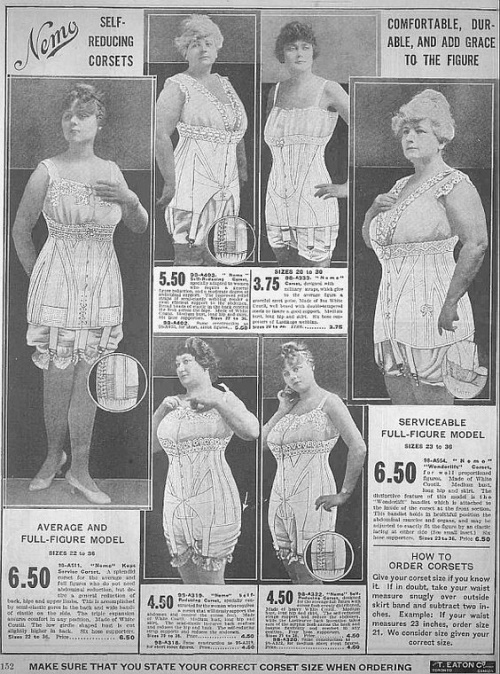
1910s Nemo Underbust Corsets
Corsets that reduced overall or concentrated on one body section were frequently seen in advertisements and catalogs. Underbust corsets reduced the middle and flattened the front. Overbust corsets reduced the figure to the ideal shape from bust to thigh. Bust reducers were like minimizer bras that looked like vests. Some corsets were lined in rubber, hoping that sweating would cause a natural reduction.
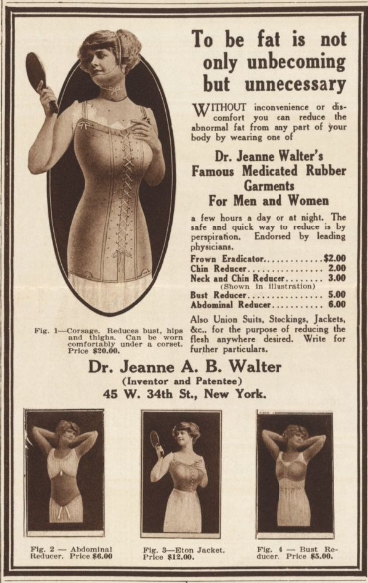
1915 Walter Corsets and Bust Reducers
Let me take a soapbox moment and say corsets, when fitted correctly, are not uncomfortable. They do wonders for posture, back, and bust support. They will also make or break your 1910s costumes, so please please please consider investing in a good corset if you are going to regularly dress in 1910s clothing. If you are only going to attend a one time event, a lifting bra and some Spanx/tummy control pantyhose will suffice.
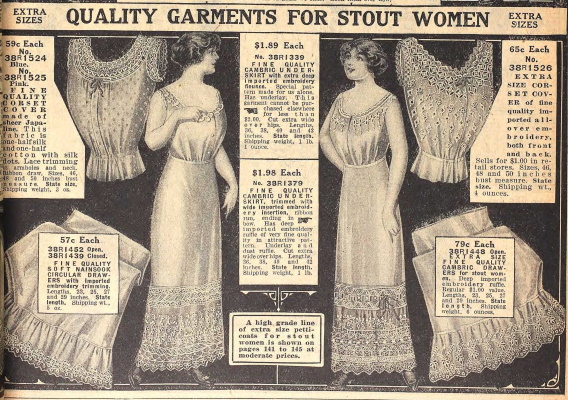
1914 Lingerie for Stout Women – Corset Cover, Drawers, and Petticoats
Other types of lingerie and nightgowns were also sold in stout sizes. In most weather a cotton corset cover, drawers (pantaloon underwear), and petticoat were all that was needed over a corset. In winter, knit “long johns” provided another layer of warmth before topping with the cotton lingerie.
Where to Buy Plus Size Edwardian Clothing
Plus Size 1910s Clothing for Women – Where to buy dresses, costumes, shoes in XL to 4Xl sizes. The list is growing. Do let me know if you have a resource to add!
Fashion History for Plus Sizes
- 1900s Edwardian Plus Size Fashions
- 1920s Plus Size Fashion in the Jazz Age
- 1930s Plus Size, Curvy, Mature Fashion Inspiration
- 1940s Plus Size Clothing: Dresses History
Debbie Sessions has been teaching fashion history and helping people dress for vintage themed events since 2009. She has turned a hobby into VintageDancer.com with hundreds of well researched articles and hand picked links to vintage inspired clothing online. She aims to make dressing accurately (or not) an affordable option for all. Oh, and she dances too.
